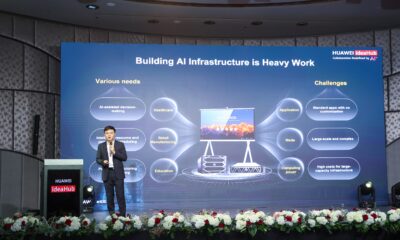Cover Story
Achieve Health Equity With Artificial Intelligence

Dr. Jassim Haji, chairman of the International Group of Artificial Intelligence (IGOAI) and a researcher in technology and AI, writes a cover feature on the transformational prospects of the healthcare sector besides the adoption of AI into patient care.
The use of artificial intelligence (AI) in healthcare was not adequate and much less compared with commercial verticals especially in modern societies, such as the United States, China, and Europe. Had there been the modern technologies used efficiently in hospitals, research labs, patient care units, and drug development centers earlier, we could have saved many lives that the COVID-19 pandemic claimed.
Concerns from similar and diverse angles had been raised by global expert communities and they were inviting the attention of various government authorities, state agencies, and private companies. Incorporating all of it, the International Group of Artificial Intelligence (IGOAI), a community of academics, students, CIOs, members of global AI associations, and professionals who engage with AI, successfully hosted a virtual summit on “The Artificial Intelligence in Healthcare” on 29th June 2022 with the theme of “AI simplifies the lives of patients, doctors, and hospital administrators by performing tasks that are typically done by humans, but in less time and at a fraction of the cost.”
The following article refers to the key areas of AI that were analyzed during the summit and they would ideally catalyze further discussions on the subject.
Supports Medical Imaging Analysis
AI is used as a tool for case triage. It supports a clinician reviewing images and scans. This enables radiologists or cardiologists to identify essential insights for prioritizing critical cases, avoid potential errors in reading electronic health records (EHRs), and establish more precise diagnoses.
Builds Complex And Consolidated Platforms For Drug Discovery
AI algorithms can identify new drug applications, tracing their toxic potential as well as their mechanisms of action. This technology led to the foundation of a drug discovery platform that enables the company to repurpose existing drugs and bioactive compounds.
Forecast Kidney Disease
Acute kidney injury can be difficult to detect by clinicians but can cause patients to deteriorate very fast and become life-threatening. With an estimated 11% of deaths in hospitals following a failure to identify and treat patients, the early prediction and treatment of these cases can have a huge impact to reduce life-long treatment and the cost of kidney dialysis.
Provides Valuable Assistance to Emergency Medical Staff
During a sudden heart attack, the time between the 911 or 999 call to the ambulance arrival is crucial for recovery. For an increased chance of survival, emergency dispatchers must be able to recognize the symptoms of a cardiac arrest to take appropriate measures. AI can analyze both verbal and nonverbal clues to establish a diagnosis from a distance.
Supports Health Equity
The AI and ML industry has the responsibility to design healthcare systems and tools that ensure fairness and equality are met, both in data science and in clinical studies, to deliver the best possible health outcomes. With more use of ML algorithms in various areas of medicine, the risk of health inequities can occur.
Natural Language Processing
Making sense of human language has been a goal of AI researchers since the 1950s. This field, NLP, includes applications such as speech recognition, text analysis, translation, and other goals related to language.
There are two basic approaches to it: statistical and semantic NLP. Statistical NLP is based on machine learning and has contributed to a recent increase in the accuracy of recognition. It requires a large “corpus” or body of language from which to learn.
Rule-Based Expert Systems
Expert systems based on collections of “if-then” rules were the dominant technology for AI in the 1980s and were widely used commercially in that and later periods. In healthcare, they were widely employed for “clinical decision support” purposes over the last couple of decades and are still in wide use today. Many electronic health records (EHR) providers furnish a set of rules with their systems today.
Physical Robots
Physical robots are well known by this point, given that more than 200,000 industrial robots are installed each year around the world. They perform pre-defined tasks, such as lifting, repositioning, welding, or assembling objects in places like factories and warehouses and delivering supplies in hospitals. Recently, robots have become more collaborative with humans and are more easily trained by moving them through the desired task. They are also becoming more intelligent, as other AI capabilities are being embedded in their “brains.”
Robotic Process Automation
This technology performs structured digital tasks for administrative purposes, i.e., those involving information systems, as if they were a human user following a script or rules. Compared to other forms of AI they are inexpensive, easy to program, and transparent in their actions. Robotic process automation (RPA) doesn’t involve robots – only computer programs on servers. It relies on a combination of workflow, business rules, and “presentation layer” integration with information systems to act like a semi-intelligent user of the systems. In healthcare, they are used for repetitive tasks like prior authorization, updating patient records, or billing.
Patient Engagement And Adherence Applications
Patient engagement and adherence have long been seen as the ‘last mile”’ problem of healthcare – the final barrier between ineffective and good health outcomes. The more patients proactively participate in their well-being and care, the better the outcomes – utilization, financial outcomes, and member experience. These factors are increasingly being addressed by big data and AI.
Administrative Applications
There are also a great many administrative applications in healthcare. The use of AI is somewhat less potentially revolutionary in this domain as compared to patient care, but it can provide substantial efficiencies.
International Group of Artificial Intelligence (IGOAI) was established in 2021 to create global awareness about artificial intelligence (AI). It disseminates learning about AI through global summits and conferences by articulating potential algorithm-based biases, security gaps, and other key areas that need feedback and scrutiny.
Cover Story
Inside Zoho’s UAE Data Centers!

Playing the Long Game in Cloud Infrastructure, Data Centers, Privacy, Cybersecurity, and Growth in the UAE
Senior Editor had an interview with Shailesh Davey, Co-founder & CEO, Zoho, during the official launch of their newly opened data centers in the UAE.
Zoho is on an executing path, perhaps as they say, it is a disciplined, long-term regional strategy by deploying and right-sizing data centers in Saudi and the UAE, aligning with global trends in data sovereignty and privacy.
The UAE is a priority growth market fueled by regulatory and business-led digitization, supported by local teams and partners. Customers will see faster performance from local hosting, while flagship products Zoho CRM Plus and Zoho Books lead growth, with rapid regulatory feature alignments.
Zoho currently operates more than 18 data centers globally, with the UAE being the latest addition. From a regional perspective, does the Middle East require more data centers, or are the facilities in the UAE and Saudi Arabia sufficient to support Zoho’s growth plans?
We currently operate two data centers in Saudi Arabia, which primarily serve the Saudi market. In the UAE, we have now established two data centers—one in Dubai and another in Abu Dhabi. These facilities have been carefully right-sized based on our expected growth in the region.
We have been present in this market since 2009, so we have a clear understanding of customer adoption patterns, data usage behavior, and growth trajectories. Based on this data, we have ensured sufficient capacity for the next two to four and a half years. Every six months, our teams review capacity utilization and growth rates. If we see demand growing faster than anticipated, we simply expand further.
This approach isn’t new for us—we’ve been doing this consistently since 2006–2007.
Zoho is widely known for its capital discipline and strong stance on privacy. With increasing global rhetoric around cybersecurity, data sovereignty, and regulations—especially in markets like the UAE—do you believe governments are emphasizing certifications due to a trust deficit with large tech companies, or is this part of a broader global shift?
There are a few important factors at play here. First, some of the world’s largest technology companies have built their businesses by monetizing user data. This is openly acknowledged as part of their business model. While it may be legal, it understandably creates discomfort—especially for governments concerned about the data of their citizens, and for individuals who often accept terms and conditions without fully realizing what they are agreeing to.
Second, we are now living in a rapidly evolving geopolitical environment. The shift toward a multipolar world has accelerated significantly over the last couple of years. In this context, it is only practical for governments to introduce regulations that ensure clarity around where data resides, how it is handled, and whether companies are compliant with local laws.
From Zoho’s perspective, this has always aligned with our philosophy. Wherever we set up data centers, we comply fully with local regulations and data sovereignty requirements. Certifications and compliance are simply proof points of that commitment.
Zoho has seen strong growth in the UAE. Which flagship products are driving this momentum, and how does the establishment of local data centers translate into tangible benefits for businesses in terms of innovation and performance?
Let me start with the impact of the data centers. The most immediate and visible benefit is speed. Earlier, customer data was being served from the US, which meant latency due to the physical distance. With local data centers in the UAE, response times are significantly faster. This directly improves user experience, in addition to meeting security and compliance requirements.
In terms of products, our fastest-growing solution in the UAE is Zoho CRM Plus. For any business, sales is a critical function, and CRM Plus is a comprehensive, customer-facing suite that supports sales, marketing, customer support, service, and even project management.
The second major growth driver is Zoho Books, which is widely used by finance and accounting teams. With increasing regulatory requirements around accounting, compliance, and e-invoicing in the UAE, Zoho Books helps businesses stay compliant while maintaining accurate and transparent financial records.
Given the pace at which regulations are evolving, especially in areas like e-invoicing, our local presence allows us to respond very quickly. We see significant long-term potential for both CRM Plus and Zoho Books in this market.
One of Zoho’s recent consumer-focused initiatives Aaratai application has gained strong traction in India and has generated a lot of discussion. Do you see similar B2C-led innovations helping Zoho reach a wider audience in the UAE as well? Could we see such solutions being developed or localized for this market?
This has been an interesting experiment for us. What we’ve essentially done is take the technology we built for the B2B world, adapt it, and make it accessible to B2C users. That’s how this particular app was born, and it received strong tailwinds in the Indian market.
Interestingly, due to the large Indian diaspora in the UAE, adoption naturally extended here as well. Our immediate focus is to ensure that the product is reliable, feature-rich, and delivers long-term value to users.
Once we are confident that the model works at scale, we will look at expanding into other markets where there is strong synergy. Markets with a significant Indian diaspora are a natural starting point, and Europe is high on that list.
Automotive
Goodyear continues support for Team De Rooy in the 2025 Dakar Rally

Goodyear continues its partnership with Team De Rooy for the upcoming Dakar Rally 2025. As the official tire supplier, Goodyear will equip the Dutch team with its high-performance Goodyear OFFROAD tires and advanced Tire Pressure Monitoring System (TPMS), helping to ensure reliable performance throughout the rally’s demanding stages. This collaboration highlights Goodyear’s dedication to truck motorsport, combining innovation with proven durability on some of the world’s toughest terrains.
Dakar 2025: new challenges await
The 2025 Dakar Rally, running from January 3 to January 17, will cover nearly 8,000 kilometers, including over 5,000 kilometers of competitive stages, starting in Bisha and finishing in Shubaytah. This edition ramps up the difficulty, featuring an early 48-hour chrono stage that flows into the marathon stage, setting a challenging pace from the outset. In the second week, competitors will tackle the demanding dunes of the Empty Quarter, with over 45% of the course on separate tracks for different vehicle classes, enhancing safety while complicating navigation.
Goodyear OFFROAD tires and TPMS: performance in challenging conditions
Team De Rooy relies on Goodyear OFFROAD tires for their durability and reliable traction across different conditions. Designed to handle heat and challenging surfaces, these tires help reduce heat buildup at high speeds and provide consistent performance on sand, rocks, and steep slopes.
Goodyear’s TPMS offers real-time monitoring of tire pressure and temperature, helping the team make quick adjustments and avoid potential issues. This advanced system helps to minimize downtime and supports better strategic decisions—crucial for maintaining momentum during the rally.
A Legacy of motorsport excellence
Goodyear’s continued support of Team De Rooy highlights its long-standing commitment to truck motorsport. As the title sponsor of the Goodyear FIA European Truck Racing Championship (ETRC), Goodyear uses motorsport as a proving ground for tire technology advancements. The partnership with Team De Rooy reflects this commitment, driving innovation and performance in demanding environments.
Maciej Szymański, Marketing Director Commercial EMEA at Goodyear, commented:
“Our continued collaboration with Team De Rooy for Dakar 2025 underscores our commitment to supporting motorsport teams in extreme conditions. With Goodyear OFFROAD tires and TPMS, we aim to provide the reliability needed to tackle the rally’s challenges. We wish Team De Rooy all the best and look forward to another exciting competition at this iconic rally”.

Cover Story
PLAUD Note Pro: This Tiny AI Recorder Might Be the Smartest Life Upgrade You Make!

By Srijith KN
I’ve been using the Plaud Note Pro for over three months now, and this is a device that has quietly earned a permanent place in my daily life now. Let me walk you through what it does—and why I say that so?
Well at first I thought this wasn’t going to do much with my life, and by the looks of it Plaud Note Pro looks like a tiny, card-sized gadget—minimal, unobtrusive to carry it around.
With a single press of the top button, it starts recording meetings, classes, interviews, or discussions. Once you end your session, the audio is seamlessly transferred to the Plaud app on your phone, where it’s transformed into structured outputs—summaries, action lists, mind maps, and more.

In essence, it’s a capture device that takes care of one part of your work so you can concentrate on the bigger game.
Design-wise, the device feels premium, it features a small display that shows battery level, recording status, and transfer progress—just enough information without distraction. The ripple-textured finish looks elegant and feels solid, paired with a clean, responsive button. It also comes with a magnetic case that snaps securely onto the back of your phone, sitting flush and tight, making it easy to carry around without thinking twice.
Battery life is another standout. On a full charge, the Plaud Note Pro can last up to 60 days, even with frequent, long recording sessions. Charging anxiety simply doesn’t exist here.
Well, my impressions about the device changed once I had an audio captured. I tested this in a busy press conference setting—eight to ten journalists around me, multiple voices, ambient noise—and the recording came out sharp and clear. Thanks to its four-microphone array, it captures voices clearly from up to four to five meters away, isolating speech with precision and keeping voices naturally forward. This directly translates into cleaner transcripts. It supports 120 languages, and yes, I even tested transcription into Malayalam—it worked remarkably well, condensed the entire convo-interview that I had during an automotive racing show that I was into.
Real meetings or interviews are rarely happens in a neat environment, and that’s where I found the Plaud Note Pro working for me. It captures nuances and details I often miss in the moment. As a journalist, that’s invaluable. The app also allows you to add photos during recordings, enriching your notes with context and visuals.
I tested transferring files over 20 minutes long, and the process was smooth and quick. Accessing the recordings on my PC via the browser was equally intuitive—everything is easy to navigate and well laid out.

Now to what is inside this tiny recorder. Well, the core of the experience is Plaud Intelligence, the AI engine powering all Plaud note-takers. It dynamically routes tasks across OpenAI, Anthropic, and Google’s latest LLMs to deliver professional-grade results. With over 3,000 templates, AI Suggestions, and features like Ask Plaud, the system turns raw conversations into organized, searchable, and actionable insights. These capabilities are available across the Plaud App (iOS and Android) and Plaud Web.
Privacy is what I happen to see them look at seriously. All data is protected under strict compliance standards, including SOC 2, HIPAA, GDPR, and EN18031, ensuring enterprise-grade security.
What makes the AI experience truly effective is the quality of input. Unlike a phone recorder—where notifications, distractions, and inconsistent mic pickup interfere—the Plaud Note Pro does one job and does it exceptionally well. It records cleanly, consistently, and without interruption, delivering what is easily one of the smoothest recording and transcription experiences I’ve used so far.
I’m genuinely curious to see how Plaud evolves this product further. If this is where they are today, the next version should be very interesting indeed.
“The Plaud Note Pro isn’t just a recorder; it’s a pocket-sized thinking partner that captures the details so you can think bigger, clearer, and faster.”
- Plaud Note Pro is now available for pre-order at https://uae.plaud.ai/pages/plaud-note-pro
- Plaud Note and NotePin are available at https://uae.plaud.ai
-

 Tech News2 years ago
Tech News2 years agoDenodo Bolsters Executive Team by Hiring Christophe Culine as its Chief Revenue Officer
-

 VAR9 months ago
VAR9 months agoMicrosoft Launches New Surface Copilot+ PCs for Business
-

 Tech Interviews2 years ago
Tech Interviews2 years agoNavigating the Cybersecurity Landscape in Hybrid Work Environments
-

 Tech News6 months ago
Tech News6 months agoNothing Launches flagship Nothing Phone (3) and Headphone (1) in theme with the Iconic Museum of the Future in Dubai
-
News10 years ago
SENDQUICK (TALARIAX) INTRODUCES SQOOPE – THE BREAKTHROUGH IN MOBILE MESSAGING
-

 Tech News2 years ago
Tech News2 years agoBrighton College Abu Dhabi and Brighton College Al Ain Donate 954 IT Devices in Support of ‘Donate Your Own Device’ Campaign
-

 VAR1 year ago
VAR1 year agoSamsung Galaxy Z Fold6 vs Google Pixel 9 Pro Fold: Clash Of The Folding Phenoms
-

 Editorial1 year ago
Editorial1 year agoCelebrating UAE National Day: A Legacy of Leadership and Technological Innovation


























Dr Mohd Rafie
August 12, 2022 at 7:18 pm
Great job Dr Jassim! You’ve highlighted areas in medicine that can definitely benefit from AI. Very excited to learn more and see more
admin
August 15, 2022 at 10:58 am
Dear Dr. Mohd Rafie,
Thank you for your comment!
Dr. Jassim had a few more takes on AI and related fields. We hope you would be interested in checking them out.
Here they are: https://varonline.com/intelligent-assistants-robot-teaches-and-more-ai-hints-exceptional-future/